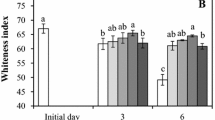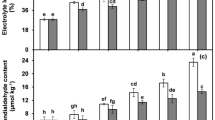Abstract
Aloe Vera (AV) gel is commonly used as a natural, inexpensive, edible coating that can improve the quality and shelf life of fruits. The objective of this study was to evaluate how two methods of applying AV, i.e. as an edible coating (dry environment) and as a gel solution (aqueous environment: a new method), prevent browning and maintain quality characteristics of fresh kernels of Persian walnut for 60 days during cold storage. Distilled water was used as a control group for both environments. In general, AV caused a reduction in the peroxide value (POV) of kernels, while preserving Total Phenolic Compound and Total Antioxidant Activity (TAA). The AV treatment slowed down the process of color change and maintained sensory properties during storage, compared to the control groups of both methods. The AV gel solution performed better than the AV edible coating in terms of POV, color (L* and h°) and microbial growth. In contrast, the AV edible coating was more effective in preserving TPC and TAA. Also, TAA was found to have a significant, positive correlation with L* and, simultaneously, a negative correlation with POV. As far as we know, this is the first instance that the AV gel was used as a formulated solution and as an edible coating on fresh fruits. This innovative method can be used in commercial practice, while being ecofriendly and non-chemical as a treatment for the maintenance of postharvest quality in fruits.





Similar content being viewed by others
Availability of data and material
All data generated or analysed during this study are included in this published article.
Abbreviations
- AV:
-
Aloe vera
- AEs:
-
Aqueous environments
- DEs:
-
Dry environments
- CAE:
-
Control aqueous environment
- AA:
-
Aloe vera aqueous environment
- CDE:
-
Control dry environment
- ADE:
-
Aloe vera dry environment
- POV:
-
Peroxide value
- TPC:
-
Total phenolic compound
- TAA:
-
Total antioxidant activity
- TCD:
-
Total color difference
- USFA:
-
Unsaturated fatty acid
- SFA:
-
Saturated fatty acid
References
Ali S, Khan AS, Nawaz A, Anjum MA, Naz S, Ejaz S, Hussain S (2019) Aloe vera gel coating delays postharvest browning and maintains quality of harvested litchi fruit. Postharvest Biol Technol 157:110960
Arab MM, Marrano A, Abdollahi-Arpanahi R, Leslie CA, Askari H, Neale DB, Vahdati K (2019) Genome-wide patterns of population structure and association mapping of nut-related traits in Persian walnut populations from Iran using the Axiom J. regia 700K SNP array. Sci Rep 9(1):1–14
Askari G, Yazdekhasti N, Mohammadifard N, Sarrafzadegan N, Bahonar A, Badiei M, Sajjadi F, Taheri M (2013) The relationship between nut consumption and lipid profile among the Iranian adult population; isfahan healthy heart program. Eur J Clin Nutr 67(4):385–389
Benítez S, Achaerandio I, Sepulcre F, Pujolà M (2013) Aloe vera based edible coatings improve the quality of minimally processed ‘Hayward’ kiwifruit. Postharvest Biol Technol 81:29–36
Cardarelli M, Rouphael Y, Pellizzoni M, Colla G, Lucini L (2017) Profile of bioactive secondary metabolites and antioxidant capacity of leaf exudates from eighteen aloe species. Ind Crops Prod 108:44–51
Castillo S, Navarro D, Zapata P, Guillén F, Valero D, Serrano M, Martínez-Romero D (2010) Antifungal efficacy of aloevera in vitro and its use as a preharvest treatment to maintain postharvest table grape quality. Postharvest Biol Technol 57(3):183–188
Chatrabnous N, Yazdani N, Tavallali V, Vahdati K (2018a) Preserving quality of fresh walnuts using plant extracts. LWT 91:1–7
Chatrabnous N, Yazdani N, Vahdati K (2018b) Determination of nutritional value and oxidative stability of fresh walnut. J Nuts 9(1):11–20
Chen X, Ren L, Li M, Qian J, Fan J, Du B (2017) Effects of clove essential oil and eugenol on quality and browning control of fresh-cut lettuce. Food Chem 214:432–439
Christopoulos T (2011) Effects of temperature and packaging atmosphere on total antioxidants and colour of walnut (Juglans regia L.) kernels during storage. Sci Hortic 131:49–57
Christopoulos T (2012) Storage of fresh walnuts (Juglans regia L.)–low temperature and phenolic compounds. Postharvest Biol Technol 73:80–88
Colarič M, Stampar F, Hudina M, Solar A (2006) Sensory evaluation of different walnut cultivars (Juglans regia L.). Acta Agric Slov 87:403–413
Ergun M, Satici F (2012) Use of aloe vera gel as biopreservative for ‘Granny Smith’and ‘Red Chief’apples. J Anim Plant Sci 22(2):363–368
Guillén F, Díaz-Mula HM, Zapata PJ, Valero D, Serrano M, Castillo S, Martínez-Romero D (2013) Aloe arborescens and Aloe vera gels as coatings in delaying postharvest ripening in peach and plum fruit. Postharvest Biol Technol 83:54–57
Habibie A, Yazdani N, Saba MK, Vahdati K (2019) Ascorbic acid incorporated with walnut green husk extract for preserving the postharvest quality of cold storage fresh walnut kernels. Sci Hortic 245:193–199
Hassanpour H (2015) Effect of Aloe vera gel coating on antioxidant capacity, antioxidant enzyme activities and decay in raspberry fruit. LWT-Food Sci Technol 60(1):495–501
Hu Q, Hu Y, Xu J (2005) Free radical-scavenging activity of Aloe vera (Aloe barbadensis Miller) extracts by supercritical carbon dioxide extraction. Food Chem 91(1):85–90
Jahanbani R, Ghaffari SM, Salami M, Vahdati K, Sepehri H, Sarvestani NN, Sheibani N, Moosavi-Movahedi AA (2016) Antioxidant and anticancer activities of walnut (Juglans regia L.) protein hydrolysates using different proteases. Plant Foods Human Nutr 71(4):402–409
Jariteh M, Ebrahimzadeh H, Niknam V, Vahdati K, Amiri R (2011) Antioxidant enzymes activities during secondary somatic embryogenesis in Persian walnut (Juglans regia L.). Afr J Biotechnol 10(20):4093–4099
Jensen PN, Sørensen G, Brockhoff P, Bertelsen G (2003) Investigation of packaging systems for shelled walnuts based on oxygen absorbers. J Agric Food Chem 51(17):4941–4947
Jiang L, Feng W, Li F, Xu J, Ma Y, Ma H (2015) Effect of One-methylcyclopropene (1-MCP) and chlorine dioxide (ClO2) on preservation of green walnut fruit and kernel traits. J Food Sci Technol 52(1):267–275
Ma Y, Lu X, Liu X, Ma H (2013) Effect of 60 Coγ-irradiation doses on nutrients and sensory quality of fresh walnuts during storage. Postharvest Biol Technol 84:36–42
Martínez-Romero D, Alburquerque N, Valverde JM, Guillén F, Castillo S, Valero D, Serrano M (2006) Postharvest sweet cherry quality and safety maintenance by Aloe vera treatment: a new edible coating. Postharvest Biol Technol 39:93–100
Martínez-Romero D, Castillo S, Guillén F, Díaz-Mula HM, Zapata PJ, Valero D, Serrano M (2013) Aloe vera gel coating maintains quality and safety of ready-to-eat pomegranate arils. Postharvest Biol Technol 86:107–112
Miller NJ, Rice-Evans CA (1997) The relative contributions of ascorbic acid and phenolic antioxidants to the total antioxidant activity of orange and apple fruit juices and blackcurrant drink. Food Chem 60(3):331–337
Nicolau-Lapeña I, Aguiló-Aguayo I, Kramer B, Abadias M, Viñas I, Muranyi P (2021) Combination of ferulic acid with Aloe vera gel or alginate coatings for shelf-life prolongation of fresh-cut apples. Food Packag Shelf Life 27:100620
Sánchez-Machado DI, López-Cervantes J, Sendón R, Sanches-Silva A (2017) Aloe vera: ancient knowledge with new frontiers. Trends Food Sci Technol 61:94–102
Shahidi F, Zhong Y (2005). Lipid oxidation: measurement methods. Bailey's industrial oil and fat products
Sheikhi A, Mirdehghan SH, Arab MM, Eftekhari M, Ahmadi H, Jamshidi S, Gheysarbigi S (2020) Novel organic-based postharvest sanitizer formulation using box behnken design and mathematical modeling approach: a case study of fresh pistachio storage under modified atmosphere packaging. Postharvest Biol Technol 160:111047
Sogvar OB, Saba MK, Emamifar A (2016) Aloe vera and ascorbic acid coatings maintain postharvest quality and reduce microbial load of strawberry fruit. Postharvest Biol Technol 114:29–35
Soltanizadeh N, Ghiasi-Esfahani H (2015) Qualitative improvement of low meat beef burger using Aloe vera. Meat Sci 99:75–80
Supapvanich S, Prathaan P, Tepsorn R (2012) Browning inhibition in fresh-cut rose apple fruit cv. Taaptimjaan using konjac glucomannan coating incorporated with pineapple fruit extract. Postharvest Biol Technol 73:46–49
Teotia S, Singh D (2014). Oxidative stress in plants and its management. In: Approaches to Plant Stress and their Management. Springer, pp 227–253
Vahdati K, Hassani D, Rezaee R, Sayadi MJ, Khorami SS (2014) Walnut Footprints in Iran.
Venkatachalam M, Sathe SK (2006) Chemical composition of selected edible nut seeds. J Agric Food Chem 54(13):4705–4714
Zapata PJ, Navarro D, Guillén F, Castillo S, Martínez-Romero D, Valero D, Serrano M (2013) Characterisation of gels from different Aloe spp as antifungal treatment: potential crops for industrial applications. Ind Crops Prod 42:223–230
Acknowledgements
The authors appreciate Iran National Science Foundation (INSF), University of Tehran and Center of Excellence for Walnut Improvement and Technology for their financial supports of this research.
Author information
Authors and Affiliations
Contributions
AH designed, performed all the experiments, compiled the data and wrote the manuscript. NY designed, directed the project and contributed to the interpretation of the results and revised the manuscript. NCH contributed to data analysis and the interpretation of the results. MKS contributed to the interpretation of the results and revised the manuscript. KV directed the project and revised manuscript. All authors listed, have made direct and intellectual contribution to the work, and approved it for publication. Also, all authors read and approved the final manuscript.
Corresponding authors
Ethics declarations
Conflict of interest
The authors declare no conflict of interest.
Ethical approval
Not applicable (include appropriate approvals or waivers).
Additional information
Publisher's Note
Springer Nature remains neutral with regard to jurisdictional claims in published maps and institutional affiliations.
Rights and permissions
About this article
Cite this article
Habibi, A., Yazdani, N., Chatrabnous, N. et al. Inhibition of browning via aqueous gel solution of Aloe vera: a new method for preserving fresh fruits as a case study on fresh kernels of Persian walnut. J Food Sci Technol 59, 2784–2793 (2022). https://doi.org/10.1007/s13197-021-05301-3
Revised:
Accepted:
Published:
Issue Date:
DOI: https://doi.org/10.1007/s13197-021-05301-3




